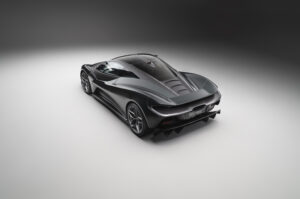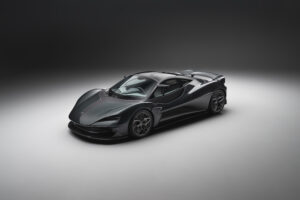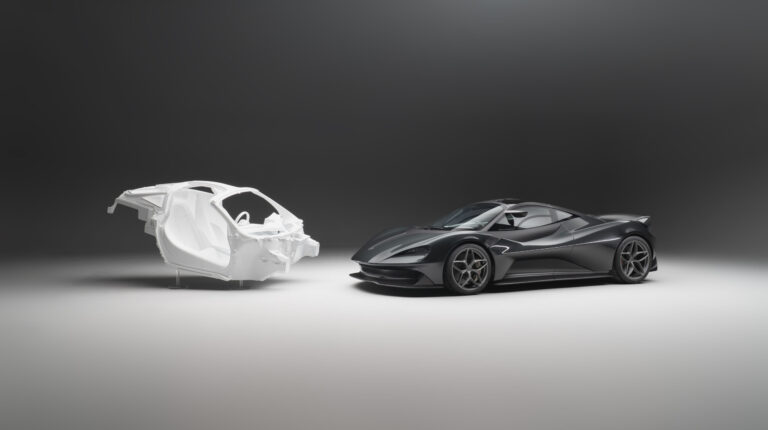Lanzante has revealed its 95-59, a three-seat 4-liter twin-turbo V8 bespoke project that celebrates the company’s win at the 1995 24 Hours of Le Mans.
“95-59 is the result of everything I personally and we, as a business, have learned and experienced over three decades since winning Le Mans,” explained Dean Lanzante, the man steering the project.
The 95-59 is based on a current McLaren platform using a reengineered carbon-fiber chassis. The supercar power will be more than 850bhp with 880Nm of torque, according to Lanzante, delivered from a revised 4.0-liter V8 twin-turbo engine combined with a 7-speed SSG transmission.
LM30 pack
With a target weight of just 1,250kg, the 95-59 is in its lightest and most distilled configuration. The LM30 pack combines saves around 20kg. It includes super-lightweight forged aluminum wheels, Inconel exhaust headers, titanium secondary and tailpipes, titanium body fixings and gold-plated heat-shielding throughout the engine bay and exhaust.
Exterior design
“95-59 has a very natural balance to it. By its very design, with the driver as the focal point, it works as a piece of design, with symmetry and very natural forms,” said chief designer Paul Howse. “The design is a continuing development of my design theory, based on the efficiencies of organic shapes, and we have worked hard to deliver something that pushes the boundaries. Like the famous win 30 years ago, 95-59 is something that has not been seen or done before. However, working closely with Dean and the team at every stage, we have developed a design that stays true to the ethos of everything Lanzante has become known for over the past three decades. For me, personally, it is also the culmination of ideas and thoughts I have had throughout my design career, working across different projects.
“The central driving position was a key part of the initial discussions for this project. We wanted something that looked organic, with an aggressive edge to it, but clean. In the same way, fighter jets are designed with purpose and poise, without superfluous intricacies and design trends. The final design is beautifully balanced and cohesive from every angle, without being ‘on trend’ or following the current design rules. It is not so much a nod to heritage, but because it is fundamentally correct, I like to think we have created something that is unlike anything else; building its own legacy.”
Digital to reality: CAD to clay
An important step in the design process was the transition from digital to reality, as CAD was transformed to clay. “The clay modeling phase was critical to how we arrived at this final shape for 95-59,” Howse noted. “From my initial sketches, and the engineering discussions with Dean, we created a CAD model where the volumes and proportions were refined and perfected using VR headsets, allowing the theme to be crafted. This laid strong foundations onto which the clay could be progressed, with the shape really taking a big step forward. From a design perspective, clay gives that sensitivity and feel like nothing else, and the program moved on significantly as we closed in on the final shapes.”
Aerodynamic air paths
With a design theory based around the efficiency of organic shapes, 95-59 has been developed on the aerodynamic air paths logic. These air paths can be identified in the two-layered design, with the lower, visual carbon-fiber surfaces that create downforce and eject high pressure from the front wheel well.

At the front, the design is dominated by the low-level leading edge of the nose, with a ballistic shape highlighting the aerodynamic form that follows from the leading edge. The hood design has been engineered with an integrated duct along its trailing edge, in place of more traditional louvers, reducing air pressure over the front wheels and maintaining a clean surface while also providing a clear visual separation for the panel and hiding any shut lines. Inside this outlet, air is channelled along the twin-layered, sculpted dihedral doors. As air flows along the flanks of the doors, it is split across the rear quarter panel and into the highly efficient bespoke radiators.
From the side profile, the aerodynamic efficiency is visually enhanced by a bullet-like trajectory design. “With 95-59, we wanted to push the bone line – or waistline – as low as possible,” explained Howse. “It is traditionally quite high on modern cars, but with a lot of work completed to lower the nose and rear packaging, we were able to keep this focal point much lower, thus lowering the visual mass of the overall package.”
The dramatic and sculpted rear features a very low-level rear deck, with a centrally mounted titanium exhaust as the focal point. Taking inspiration from the brutalist-organic forms of the fifth-generation F22 fighter jet, this sits below a floating active aero rear wing.
Completing the design, 95-59 sits on newly designed lightweight forged-aluminum wheels that have links to the F1 GTR but also pick up on the sculpture of the body– 19-inch at the front, 20-inch at the rear.
Related news: Read about the unveiling of Lamborghini’s latest GT3 racer, based on the Temerario road car. Company chairman and CEO Stephan Winkleman said, “The Temerario GT3 is the first racing derivative of the Temerario project, further emphasizing Lamborghini’s strong belief in motorsport as a key tool for promoting our road cars



